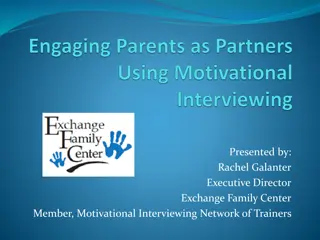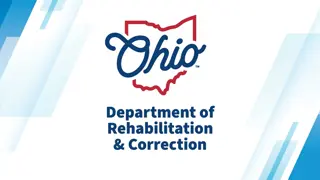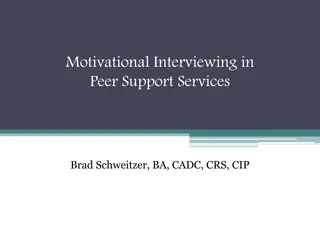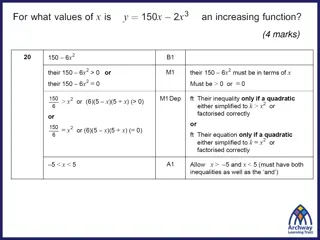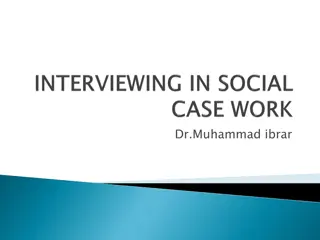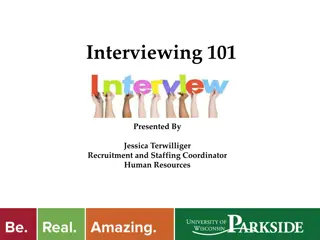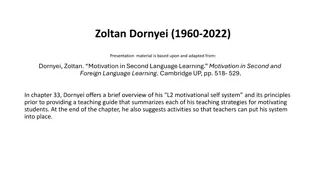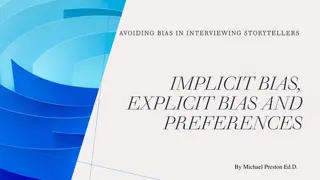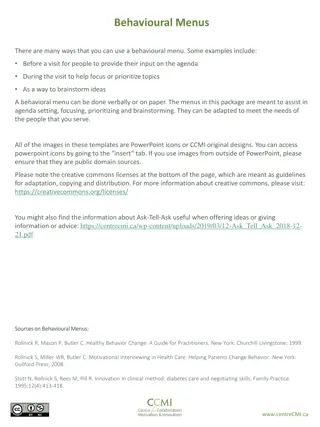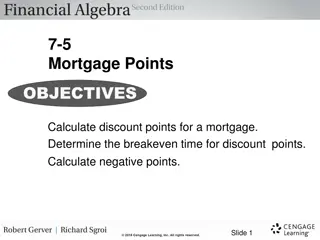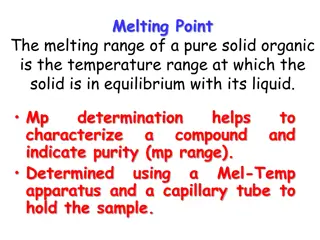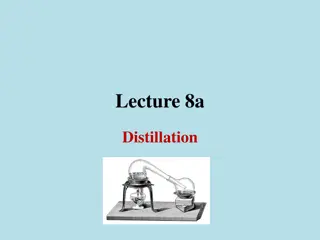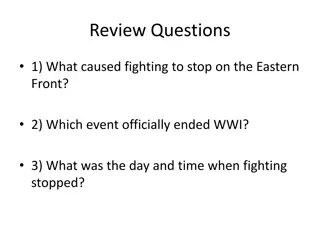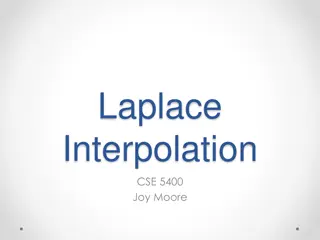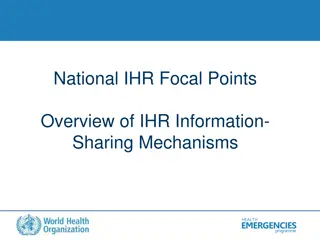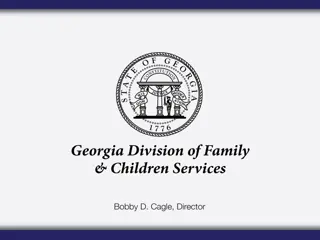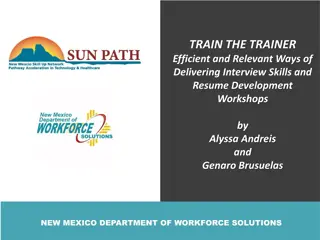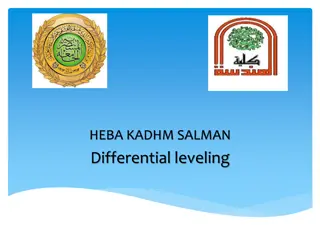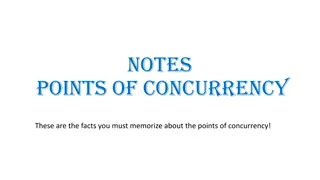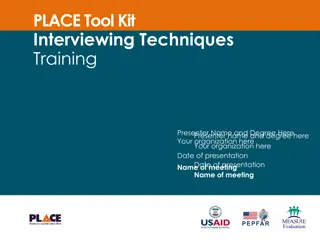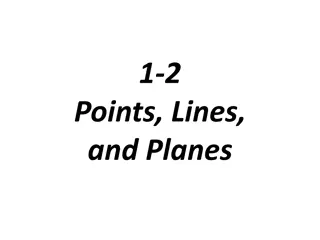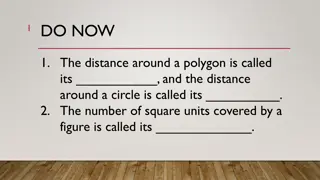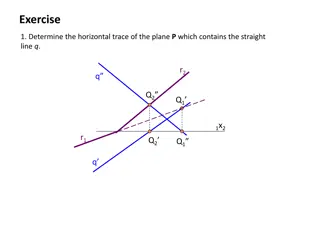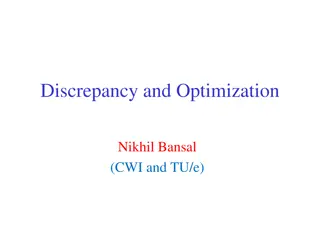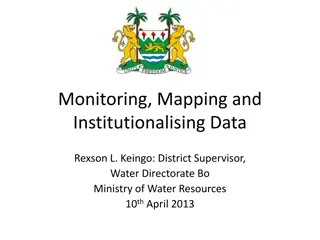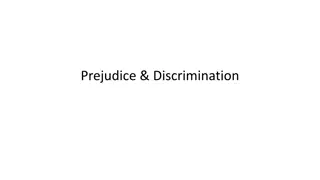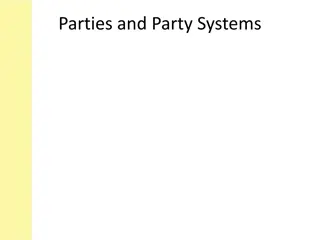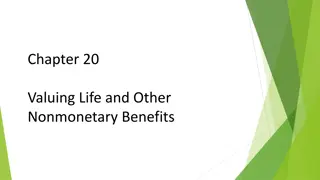Motivational Interviewing: An Overview and Key Points
Motivational Interviewing is a client-centered approach that focuses on enhancing motivation for change. It involves stages of change, where the client is responsible for their transformation. The process emphasizes creating a positive atmosphere for growth and utilizing persuasive strategies. Additionally, the content also explores key points about change, highlighting its challenges, need for creativity, and emotional aspects.
Download Presentation

Please find below an Image/Link to download the presentation.
The content on the website is provided AS IS for your information and personal use only. It may not be sold, licensed, or shared on other websites without obtaining consent from the author. Download presentation by click this link. If you encounter any issues during the download, it is possible that the publisher has removed the file from their server.
E N D
Presentation Transcript
MOTIVATIONAL INTERVIEWING: AN OVERVIEW Jeremy Wampler, LCSW, LADC, ICGC-II, BACC Director, DMHAS Problem Gambling Services Jeremy.Wampler@ct.gov
MOTIVATIONAL INTERVIEWING W. Miller & S. Rollnick Trapped by Ambivalence Procrastination, Self Esteem, Self Assertion Conflict between Indulgence & Restraint Self-Regulation, Draw on Principles of Social, Cognitive and Motivational Psychology Client Matching Nothing Works for Everyone Counselors must be comfortable with this or they may feel frustrated with a slow paced, ineffectual approach
Motivational Interviewing Based on Stages of Change (Prochaska & DiClementi) Interventions based on enhancing client s presenting level of motivation
Motivational Interviewing Counselor/case manager is not the expert Client has responsibility for change Strategies are more persuasive than coercive More supportive than argumentative Counselor/case manager seeks to create a positive atmosphere conducive to change
Motivation It is impossible to have an unmotivated client. Everybody is always motivated towards something. The question is what?
Why Do People Change? 1. ? 2. ? 3. ?
What prevents people from change? 1. ? 2. ? 3. ?
Key Points about Change 1. Change is difficult and not always comfortable 2. It is easier to stay the same 3. We tend to go back to old ways 4. Change requires creativity 5. Change requires an open mind 6. Change has emotional and cognitive components Broffman, 2011
Key Points about Change 7. Change happens over time 8. The process is as important as the result 9. Often there is a difference between what someone knows they should do and there readiness to do it. 10.Greatest chance to impact change is pairing it to the specific stage of change. Broffman, 2011
Spirit of Motivational Interviewing Collaboration Evocation Autonomy
Collaboration Helper approaches consumer as a partner Non-authoritarian Exploration and support Opposite: Confrontational or coercive approach
Evocation Eliciting or drawing out motivation from a client Drawing on the clients own goals and perceptions presumed to reside in the client Opposite: Education, enlightenment by an expert
Autonomy All responsibility for change lies with the client Respect for autonomy of the client Client freedom to accept or not accept counsel Opposite: Client told what to do or what he/she should do
Motivational Cycle and Stages of Change Action Maintenance Lapse or Relapse Planning Contemplation Precontemplation
Matching Intervention to Motivation Precontemplation Not thinking about change Not seeing the problem
Matching Intervention to Motivation Precontemplation Goals: Understand current behaviors/patterns Understand nature of client s resistance to consider change Assess client s sense of self-efficacy Express empathy and acceptance Provide new information Identify client s goals for health & well-being Just think about it
Matching Intervention to Motivation Contemplation Willing to consider a possibility of change Contemplation is not commitment HOWEVER Ambivalence can keep client stuck
Matching Intervention to Motivation Contemplation Anticipate obstacles to change Work on enhancing coping skills and self-efficacy Small steps toward change and commitment Cost-Benefit Analysis of behavior and of change Evaluate past attempts at changing behavior Goals: Decrease ambivalence Strengthen intention to change
Decisional Balance 1) Positive aspects of staying the same(what are the positive things?) 3) Negative aspects of change (what do I lose if I change?) 2) What are the negative consequences staying the same(current and future?) 4) What are the advantages of change(what do I have to gain?)
Matching Intervention to Motivation Preparation Commitment to stop/change doesn t make it happen automatically Assess strength of client s commitment Anticipate problems and pitfalls Provide choices Develop coping skills and specific action plan Goal: Take action
Matching Intervention to Motivation Action Ready to implement plan Use counseling as reinforcement of commitment External support and motivator Help increase self-efficacy Can offer information about range of options for action and change Monitor change Goal: Support action and change
Matching Intervention to Motivation Maintenance Relapse prevention and coping Recycle through stages Goal: Maintain new behaviors, continue positive change
Matching Intervention to Motivation Recurrence/Lapse/Relapse 1. Encourage client to reenter change cycle and reinforce willingness to do so. 2. View recurrence as learning opportunity vs. failure. 3. Reinforce use of coping strategies (don t use shortcuts). 4. Maintain supportive contact.
Basic Methods Open questions Affirmation Reflective listening Summary Miller & Rollnick, 2002
Open-ended questions Open-ended questions are ones that require more than one word answers. What are you planning to buy today at the grocery store? Why is it that every time I talk with you, you seem irritated? What is your favorite flavor of ice cream and why?
Affirmations Ways to point out the positive aspects of person Behavior Intention Struggles Thinking Feelings Traits, qualities Affirmations are free Used not nearly enough
Reflective Listening Client: I know we made all these goals about my getting out and meeting people, but I m just not comfortable around other people. Worker: Getting the support you need hasn t been easy. Broffman, 2011
Summary Special form of reflective listening Structure: Indicate you re about to summarize Be selective Note ambivalence and attend to change statements Be concise! End with invitation Use to change directions or ask a key question Broffman, 2011
Eliciting Change Talk Pushing the ambivalence envelope Decisional balance between change and the status quo. Disadvantages of the status quo. Advantages of change. Optimism about change. Intention to change. Miller & Rollnick, 2002
Listen for Change Talk Desire I want/wish/prefer to Ability I can, could, able, possible Reason Why do it? What would be good? Important, have to, matter, got to I will/ am going to signals behavior change Need Commitment Broffman, 2011
Assessment Outline: Strengths Support systems Life Accomplishments Recovery Experience Employment/Job skills and training Finances Character Assets Health
Brief Interventions Focus on motivation is not counseling, skill training etc. Once motivational decision is made - client may proceed to apply his or her own natural skills to accomplish change
Motivational Traps Question Answer Trap Close ended questions brief responses Leading questions that address cm agenda Active cm passive client
Motivational Cycle: Case Manager vs. Client Action Maintenance Counselor/CM Lapse or Relapse Planning Client Contemplation Precontemplation
Motivational Traps Question Answer Trap:Solution Use questionnaires to get specific information Open ended questions followed by reflective listening Avoid asking too many questions in a row (even open ended ones)
Motivational Traps Confrontation-Denial Trap Counselor through best intentions presents information to move client to awareness of their problem and its consequences and prescribes course of action too quickly Client response: My problem isn t that bad and I don t really need to do all that
Motivational Traps Confrontation-Denial Trap Natural result of client s ambivalence. In conflict over some awareness of need to change gambling and reluctance to give up hopes, fantasies, familiar behavior If counselor argues for one side of the conflict, client will take opposing side
Motivational Traps It s not that bad. It s under control You have a Big Problem
Motivational Traps Becomes win lose dynamic When confronted more forcefully, client can argue themselves out of any change at all in order to win
Motivational Traps Confrontation Denial Trap: Solution How can the client win therapy Listen Empathic reflection Elicit self-motivating statements
Motivational Traps Labeling Trap Labels can carry stigma Can create power struggle Client can feel trapped Lead to confrontation-denial trap Difficult
Motivational Traps Labeling Trap: Solutions De-emphasize label If client raises the issue can respond with reflection and reframing
Motivational Traps Premature Focus Trap Focusing on one issue as the problem while the client s focus is on other issues The Blaming Trap Client s sensitivity to being blamed
Difficult Clients: Client Resistance Client resistance is a helper problem Extent to which clients resist is strongly related to helper s style Resistance from the interpersonal interaction of helper and client Means there is something helper can do about it
Difficult Clients: Styles of Client Resistance Arguing Interrupting Denying Blaming, Disagreeing, Excusing, Claiming impunity, Minimizing, Reluctance, Unwillingness to change, Pessimism Ignoring Misdirection, Inattention, No answer, Not responding
Responses to Avoid Never meet resistance head-on via arguing, disagreeing, challenging judging, criticizing, blaming warning of negative consequences persuading via logic or evidence interpreting or analyzing reasons for resistance confronting with authority using sarcasm or incredulity *Remember the key is to Roll with the Resistance
Difficult Clients: Strategies Shifting Focus Going around barrier, taking a detour Rolling with Resistance Agreeing in part with resistance and slightly changing emphasis or focus Emphasizing Personal Choice and Control Reframing Acknowledge validity of client s observations while offering a new interpretation
Difficult Clients: Strategies Self-Motivational Statements Problem Recognition Expression of Concern Intention to Change Optimism about Change
Difficult Clients: Strategies Eliciting Self-Motivational Statements Evocative Questions Cost-Benefit Balance Elaboration Describing Extremes Looking Back Looking Forward Exploring Goals


